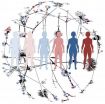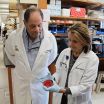(Press-News.org) Vanderbilt University scientists have found evidence that the insulin-secreting beta cells of the pancreas, which are either killed or become dysfunctional in the two main forms of diabetes, have the capacity to regenerate.
The surprising finding, posted online recently by Cell Metabolism, suggests that by understanding how regeneration occurs, scientists one day may be able to stop or reverse the rising tide of diabetes, which currently affects more than 8 percent of the U.S. population.
The study "provides clues to how we might learn what signals promote beta-cell regeneration in type 1 and type 2 diabetes," said Alvin Powers, M.D., the paper's senior author and director of the Vanderbilt Diabetes Center.
In the past three months, the Powers group at Vanderbilt, in four separate papers, has reported important findings about the "microenvironment" of the insulin-secreting beta cells and glucagon-secreting alpha cells, which are among four types of cells clustered in "islets" in the pancreas.
Both hormones are important in regulating blood glucose levels and ensuring that glucose is delivered to muscles and brain to be burned as fuel, and stored in the liver. Powers called the islets a "mini-organ" because they are highly vascularized and innervated, and exist within a specialized environment.
In type 1 diabetes, the beta cells are destroyed and glucose levels rise in the blood because not enough insulin is being produced. In type 2 diabetes, a frequent consequence of obesity, tissues become resistant to insulin, again causing blood glucose to rise. Beta cell function also becomes abnormal.
Marcela Brissova, Ph.D., research assistant professor of Medicine, was first or co-first author on three of the manuscripts. Chunhua Dai, M.D., research assistant professor of Medicine; and Kristie Aamodt and Rachel Reinert, Ph.D., students in the Vanderbilt M.D./Ph.D. program, were also among the first or co-first authors.
In two papers in the journal Diabetes and one each in Development and Cell Metabolism, the researchers described four main findings about islet vascularization and innervation:
First, vascular endothelial growth factor A (VEGF-A) is important for development of the islets' blood supply and for beta-cell proliferation. Blocking the growth factor early in development in a mouse model ultimately reduced beta-cell mass and insulin release and impaired glucose clearance from the bloodstream.
Other Vanderbilt scientists involved in this work were postdoctoral fellow Fong Cheng Pan, Ph.D., and Owen McGuinness, Ph.D., professor of Molecular Physiology and Biophysics.
Second, VEGF and other "signals" released by the endothelial cells lining islet blood vessels consequently stimulated growth of islet nerves in mice that connected to the brain.
"If the islets don't become vascularized properly, they don't become innervated properly," Brissova said. These signals also promote beta cell growth.
Other Vanderbilt scientists involved in this research were Ambra Pozzi, Ph.D., professor of Medicine, and Christopher V.E. Wright, D.Phil., Louise B. McGavock Professor, Department of Cell and Developmental Biology.
Third, VEGF-A was not involved when the beta-cell mass increased in an obese mouse model of type 2 diabetes in response to rising glucose levels.
Unlike tumors, which sprout new blood vessels as they grow, the beta-cell tissue increased its blood supply by dilating existing vessels.
Other Vanderbilt scientists involved in this research were Takamune Takahashi, M.D., Ph.D., associate professor of Medicine; Masakazu Shiota, DVM, Ph.D., associate professor of Molecular Physiology and Biophysics; and Eric H. Liu, M.D., assistant professor of Surgery.
Finally, too much VEGF-A can lead to beta cell death. But that sets up a regenerative microenvironment involving an interaction of vascular endothelial cells and macrophages which, in turn, leads to beta cell proliferation both in mice and human islets.
"That's very, very unusual because islet cells are like neurons; once they're dead, they don't usually regrow," Brissova said. "We think that the endothelial cells and macrophages which are recruited from the bone marrow create an environment that promotes the proliferation and regeneration of those beta cells."
INFORMATION:
Diabetes affects 26 million Americans and cost the country $245 billion in 2012, according to the American Diabetes Association.
The studies were supported in part by several grants from the National Institutes of Health including DK06903, DK068764, DK089572, DK066632, DK063439 and DK072473 and a Merit Review Grant from the VA Research Service.
Vanderbilt diabetes researchers track cells' ability to regenerate
2014-03-19
ELSE PRESS RELEASES FROM THIS DATE:
Critical illness increases risk of psychological problems
2014-03-19
Fortunately, more and more people survive critical illnesses and accidents. A new Danish-American survey shows, however, that hospitalisation where the patient has received mechanical ventilation can have serious consequences:
- Of course, the good news is that more and more patients survive critical illness and treatment using ventilators. But at the same time, the bad news is that we have now documented that the ventilator patients have a considerable risk of developing psychological problems.
The first few months after discharge are really critical, says professor ...
Multidisciplinary research team led by Tufts CTSI proposes new model for clinical trials
2014-03-19
BOSTON (March 19, 2014) – Experts across academia, industry and government propose a new method for health care providers to get the right treatments to the right patients at the right time. This new approach, A Proposal for Integrated Efficacy-to-Effectiveness (E2E) Clinical Trials, published in Nature Clinical Pharmacology & Therapeutics, recommends a seamless transition from controlled experiments to real-world comparative effectiveness trials. This continuum will improve the accuracy of treatment selection and better determine how those treatments work on different ...
Lied-to children more likely to cheat and lie
2014-03-19
People lie – we know this. People lie to kids – we know this, too. But what happens next? Do children who've been lied to lie more themselves?
Surprisingly, the question had not been asked experimentally until Chelsea Hays, then an undergraduate student in psychology at the University of California, San Diego, approached professor Leslie Carver with it. Now the pair have a paper out in Developmental Science, suggesting that adult dishonesty does make a difference, and not in a good way.
"As far as we know," said Carver, associate professor of psychology and human development ...
Small step towards growing tissue in the lab
2014-03-19
University of Adelaide mathematicians have devised a method for identifying how cell clusters have formed by analysing an image of the cluster.
Published in the Journal of Theoretical Biology, their mathematical modelling tool will be useful in helping biologists and tissue engineers to move towards growing human tissue such as liver in the laboratory.
"When any tissue or organ develops, the cells have to organise themselves into the correct structure," says Dr Edward Green, researcher in the University's School of Mathematical Sciences. "This self-organisation process ...
Ancient DNA shows moa were fine until humans arrived
2014-03-19
A study by Curtin University researchers and colleagues from Denmark and New Zealand strengthens the case for human involvement in the disappearance of New Zealand's iconic megaherbivore, the moa - a distant relative of the Australian Emu.
All nine species of New Zealand moa, the largest weighing up to 250 kilograms, became extinct shortly after Polynesians arrived in the country in the late 13th century.
Researchers have previously suggested, from limited genetic evidence, that huge populations of moa had collapsed before people arrived and hence influences other ...
No-refrigeration, spray vaccine could curb diseases in remote areas
2014-03-19
DALLAS, March 19, 2014 — A new kind of single-dose vaccine that comes in a nasal spray and doesn't require refrigeration could dramatically alter the public health landscape — get more people vaccinated around the world and address the looming threats of emerging and re-emerging diseases. Researchers presented the latest design and testing of these "nanovaccines" at the 247th National Meeting & Exposition of the American Chemical Society (ACS), the world's largest scientific society.
Their talk was one of more than 10,000 presentations at the meeting, being held here ...
Understanding binge eating and obesity
2014-03-19
VIDEO:
In this JoVE video article, a set of methods to measure food-related motivation and values are described in JoVE's peer-reviewed video article format.
Click here for more information.
March 19, 2014 —Researchers at the University of Cambridge have developed a novel method for evaluating the treatment of obesity-related food behavior. In an effort to further scientific understanding of the underlying problem, they have published the first peer-reviewed video of their technique ...
101 liver cancer drug candidates pave the way to personalized medicine
2014-03-19
The heart disease drug perhexiline is one of 101 compounds predicted to prevent cancer growth in most patients suffering from our most common liver cancer, HCC. This is an outcome from a novel simulation-based approach using personal sets of proteins of six HCC patients.
"This is the first time personalized models have been used to find and evaluate new potential drugs," says Professor Jens Nielsen at Chalmers University of Technology.
--
Our most common liver cancer, Hepatocellular carcinoma, HCC, causes more than half a million deaths worldwide every year. If the ...
Gut bacteria can cause life-threatening infections in preterm babies
2014-03-19
Babies born prematurely are surviving in increasing numbers. But many withstand complications of early birth only to suffer late-onset sepsis — life-threatening bloodstream infections that strike after infants reach 72 hours of age.
While early-onset sepsis often is caused by pathogens acquired from the amniotic sac or birth canal, the causes of late-onset sepsis have been far less clear.
But now, researchers at Washington University School of Medicine in St. Louis have discovered that preterm babies' guts harbor infectious microbes that can cause late-onset sepsis.
The ...
Drinking alcohol several times a week increases the risk of stroke mortality
2014-03-19
Consuming alcohol more frequently than twice a week increases the risk of stroke mortality in men, according to a study carried out at the University of Eastern Finland. The results show that the effects of alcohol are not limited to the amount consumed, but also the frequency of drinking matters. The results were published in Acta Neurologica Scandinavica on 8 March.
Excessive consumption of alcohol is associated with a variety of different diseases. The relationship between alcohol consumption and ischaemic stroke shows a J curve pattern, which means that in people ...




